
About UsThe Numismatic Bibliomania Society is a non-profit organization promoting numismatic literature. For more information please see our web site at coinbooks.org SubscriptionsThose wishing to become new E-Sylum subscribers (or wishing to Unsubscribe) can go to the following web page link MembershipThere is a membership application available on the web site Membership Application To join, print the application and return it with your check to the address printed on the application. Membership is only $20 to addresses in the U.S., $25 for First Class mail, and $30 elsewhere. For those without web access, write to: David M. Sundman, Treasurer AsylumFor Asylum mailing address changes and other membership questions, contact David at this email address: dsundman@LittletonCoin.com SubmissionsTo submit items for publication in The E-Sylum, just Reply to this message, or write to the Editor at this address: whomren@gmail.com
BUY THE BOOK BEFORE THE COIN |
- WAYNE'S WORDS: THE E-SYLUM MAY 18, 2014
- SKLOW MAIL BID SALE #22 CLOSES JUNE 7, 2014
- NEW BOOK: WHITMAN ENCYCLOPEDIA OF OBSOLETE PAPER MONEY
- NEW BOOK: DIARY OF LEONARD WYON 1853—1867
- NEW BOOK: HONOURS OF THE BRITISH RAJ
- NEW BOOK: COINS FROM THE ALPHA BANK COLLECTION
- NEW BOOK: A CATALOG OF GEORGIAN COINS
- NEW BOOK: ESSAYS IN HONOUR OF ROBERTO RUSSO
- NEW BOOK: THE HISTORY OF ISAAC NEWTON’S PAPERS
- COLUMBUS-AMERICA GROUP SUES ODYSSEY
- MICHAEL LORZ ON THE SS CENTRAL AMERICA LITIGATION
- MORE ON HENRY BERGOS
- CASH IN YOUR COINS ... AND BOOKS!
- NOTES FROM E-SYLUM READERS: MAY 18, 2014
- 1988 GEORGE FREDERICK KOLBE GOOD-FOR TOKEN
- AN APPROACH FOR CATALOGUING PRISON SCRIP
- THE CARDBOARD TOKENS OF G. H. KENT
- MORE ON THE RETAIL COIN DEALERS ASSOCIATION
- GENE & TOM'S NUMISMATIC DIARY: MAY 18, 2014
- FLIGHT 93 FALLEN HEROES OF 9/11 MEDAL DESIGNS
- NEW YORK FALLEN HEROES OF 9/11 MEDAL DESIGNS
- MARCH OF DIMES COIN DESIGNS
- PREHISTORIC ART IN NUMISMATICS
- COINS OF THE VANDALS
- JOUSTING IN NUMISMATICS
- BINI BOOK OF 1891 CHILEAN REVOLUTION NOTES
- RICHARD LISSNER WORLD COIN COLLECTION SALE
- THE LOS ANGELES SUNDAY MORNING NUMISMATIC GET TOGETHER
- RECIPE FOR MAKING COUNTERFEIT U.S. NOTES
- COUNTERFEITER FRANK BOURASSA
- SUDBURY'S BIG NICKEL GETS A NEW MEDAL
- FEATURED WEB PAGE: JOAN OF ARC MEDALS
Click here to access the complete archive
To comment or submit articles, reply to whomren@gmail.com
WAYNE'S WORDS: THE E-SYLUM MAY 18, 2014

The E-Sylum is the electronic sibling of The Asylum, the quarterly print journal for numismatic bibliomaniacs - people crazy about coin books. It was on this week in 1817 that the Asylum for the Relief of Persons Deprived of the Use of Their Reason was founded in Philadelphia. Founded by Quakers, it was the first private mental health hospital in the United States.
Our new subscribers this week include Roger Noble. Welcome aboard! We have 1,730 email subscribers.
This week we open with an note form David Sklow about his upcoming literature sale, SEVEN new books, and the latest developments surrounding the recovery of artifacts from the SS Central America.
Other topics include Henry Bergos, Hank Bieciuk, prison tokens, the Fallen Heroes of 9/11 medal designs, coins of the Vandals, the work of Leonard Wyon, and Sudbury's Big Nickel.
To learn more about the cardboard tokens of G. H. Kent, Rafael Bini's Chilean Revolution notes, the Richard L. Lissner world coin collection, Purple Power and jousting in numismatics, read on. Have a great week, everyone!
Wayne Homren
Editor, The E-Sylum
SKLOW MAIL BID SALE #22 CLOSES JUNE 7, 2014
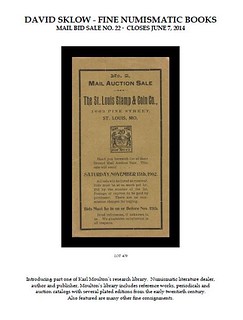 David Sklow-Fine Numismatic Books will have its MBS # 22 closing on June 7, 2014 at 8 PM. Bidding will be via Email, Telephone, Fax and Mail, bids will be accepted that are received by Email, Fax or Telephone message up to midnight on closing day. The sale consists of over 1000 lots of a well-diversified nature, featuring the Numismatic Library of Dealer, Author and Publisher, Karl Moulton. The sale is rich in auction catalogs, both deluxe and regular issues. Our terms of sale remain the same as previous sales.
David Sklow-Fine Numismatic Books will have its MBS # 22 closing on June 7, 2014 at 8 PM. Bidding will be via Email, Telephone, Fax and Mail, bids will be accepted that are received by Email, Fax or Telephone message up to midnight on closing day. The sale consists of over 1000 lots of a well-diversified nature, featuring the Numismatic Library of Dealer, Author and Publisher, Karl Moulton. The sale is rich in auction catalogs, both deluxe and regular issues. Our terms of sale remain the same as previous sales.
Some highlights of the sale are:
- Manuscript proof of The Flowing Hair Silver Dollars of 1794 by Logies.
- United States Mint at Philadelphia, 1903 hard bound by Jas. Rankin Young.
- Hard bound set of The John J. Pittman Sales by Akers.
- Long run of auction sales by Thomas L. Elder.
- Plated Mougey Sale by Elder.
- Plated Lawrence Sale by Elder.
- Empire Coin Co. [Q. David Bowers] first and only sale.
- Auction Sales by William Hesslein.
- Long run of Kosoff & Numismatic Gallery Sales.
- Long run of sales by B. Max Mehl.
- Deluxe leather edition of the Morse, Faelton and Todd sale by B. Max Mehl, ex: F.C.C. Boyd's personal copy inscribed to him by Mehl.
- Deluxe leather edition of the William Forrester Dunham sale by B. Max Mehl.
- Deluxe leather edition of the William Culter Atwater sale by B. Max Mehl.
- Complete original set of Numismatic Scrapbook.
- Long run of the Colonial Newsletter 1960 - 1998.
- Penn-New York Auction Co. first sale [Bowers & Ruddy] 1957.
- Long run of Jess Peters sale catalogs.
- Long run of Norman Shultz sale catalogs.
- Long run of St. Louis Stamp & Coin Co. sale catalogs.
- Plated Geo. W. Rice sale by St. Louis Coin & Stamp Co. 1906.
- Triple Cities Coin Exchange [James F. Ruddy] sale 1956.
- Long run of official convention auction sales of the American Numismatic Association 1907 - 1952.
- Rare August 27, 1917 Wayte Raymond sale A.N.A.
- The Twelve Caesars, 1877 by Robert Morris.
- Long run of The Numismatist 1895-1939 in original covers.
- Run of nineteenth century auction catalogs.
- Long run of hard bound Bowers & Merena sale catalogs.
- Forging His Own Chains... 1891 by George Bidwell.
- The original color transparencies for the covers and plates of the Armand Champa Library Sales Parts II & III.
- The Lettered Edge, journal of the Bust Dollar Club, 1978-79.
- A very rare and unique journal of Armand Champa's from 1973, detailing catalogs and references.
- An Arrangement of Provincial Coins, Tokens and Medalets Issued in Great Britain, Ireland, and the Colonies..... 1798 by James Conder, with many annotations.
- Run of Evans Illustrated History of the Mint.
- American Autographs [two volume set] 1983 first edition by Charles Hamilton.
- Lays of Ancient Rome 1847 by Thomas Babington Macaulay.
- Unique layout and paste up example with original photographs of the Invasion of Louisville 1988 by The Money Tree.
- Rare first issue of the Society of Bearded Numismatists Journal, S.O.B. SERVATIONS, 1977.
- Rare Mr. RedBook booklet [1978] signed by R.S. Yeoman.
- Numismata Graeca: Greek Coin Types, 1911-1913 by L. Anson.
- Several Sylloge Nummorum Graecorum.
- Super Deluxe full leather limited numbered, A California Gold Rush History by Q. David Bowers.
- The American Numismatical Manual 1859 by Montroville Wilson Dickeson.
- Deluxe full leather edition of Private Gold Coins and Patterns 1981 by Donald Kagin.
- The Palace Collection 1954 by Sotheby & Co.
- Fifty-Year Membership Medal of the American Numismatic Association, [1948] first year of issue Member No. 231 Alfred B. Aubrey.
- and much more!
The catalog is fully indexed, but, please be sure to check every page, so you will not miss those items you are really looking to add to your library!
Good luck, bid early and bid often!
David Sklow-Fine Numismatic Books
P.O. Box 6321
Colorado Springs, CO 80934
PH: 719-302-5686
FAX: 719-302-4933
Email: numismaticbooks@aol.com
Web Site: FineNumismaticBooks.com
NEW BOOK: WHITMAN ENCYCLOPEDIA OF OBSOLETE PAPER MONEY
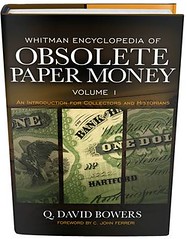 Whitman Publishing announces the impending release of volumes 1 and 2 of the Whitman Encyclopedia of Obsolete Paper Money, by Q. David Bowers. Each volume is an 8.5 x 11–inch hardcover book printed in full color on high-quality paper. Volume 1 is “An Introduction for Collectors and Historians.” Volume 2 is the first of three volumes on the New England states. The books will debut at the Memphis International Paper Money Show, June 12, 2014. After that they will be available from booksellers and hobby shops nationwide, and online (including at www.Whitman.com), for $39.95 each. The books can also be borrowed for free as a benefit of membership in the American Numismatic Association, through the Dwight N. Manley Numismatic Library.
Whitman Publishing announces the impending release of volumes 1 and 2 of the Whitman Encyclopedia of Obsolete Paper Money, by Q. David Bowers. Each volume is an 8.5 x 11–inch hardcover book printed in full color on high-quality paper. Volume 1 is “An Introduction for Collectors and Historians.” Volume 2 is the first of three volumes on the New England states. The books will debut at the Memphis International Paper Money Show, June 12, 2014. After that they will be available from booksellers and hobby shops nationwide, and online (including at www.Whitman.com), for $39.95 each. The books can also be borrowed for free as a benefit of membership in the American Numismatic Association, through the Dwight N. Manley Numismatic Library.
The Whitman Encyclopedia of Obsolete Paper Money is a multiple-volume study of currency issued from 1782 to 1866, before the modern era of National Banks and the Federal Reserve. Over the course of these decades more than 3,000 state-chartered banks issued their own paper money.
In this magisterial set of standard references, the “Dean of American Numismatics,” Q. David Bowers, has compiled decades of research from 18th- and 19th-century bank reports, contemporary newspapers, and other primary sources. He gives the history of every state, every town and city, and every bank that issued this uniquely American currency. Each note is studied, and thousands are pictured in full color, with information on grading, rarity, values, significant auction results, advice for collectors, and more.
Active collectors, researchers, dealers, historians, and other experts have volunteered their time and knowledge to help create this new encyclopedia series.
The Whitman Encyclopedia of Obsolete Paper Money is a project of grand scope, a gathering of stories about our nation—from small town to big city, from the early days following the Revolution to the tribulations of the Civil War. It paints a beautifully detailed landscape of America and its early money.
The 288-page volume 1 is the beginning of the journey: an introduction to obsolete paper money and an overview of the hobby. In the 752-page volume 2, Bowers gives the history of every town and city, as well as of every bank that issued this uniquely American currency, in the New England states of Connecticut, Maine, and New Hampshire.
Future volumes will cover the Mid-Atlantic states, the American Midwest, the South Atlantic states, the District of Columbia, and territories.
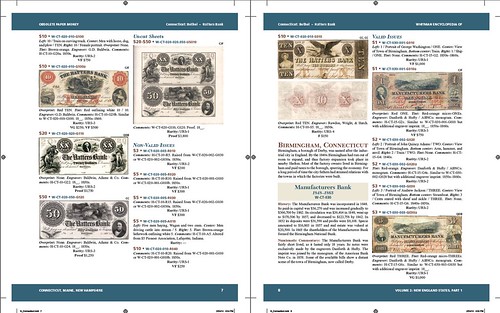
Whitman Encyclopedia of Obsolete Paper Money
Volume 1: An Introduction for Collectors and Historians
By Q. David Bowers; foreword by C. John Ferreri
ISBN 079483939-8
Hardcover, 8.5 x 11 inches
288 pages
Full color
Retail $39.95 U.S.
For more information, or to order, see: Whitman Encyclopedia of Obsolete Paper Money, Volume 1 (www.whitman.com/store/Inventory/Detail/Whitman-Encyclopedia-of-Obsolete-Paper-Money-Volume-1+0794839398)
NEW BOOK: DIARY OF LEONARD WYON 1853—1867
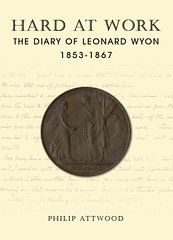 Hard at Work—The Diary of Leonard Wyon 1853—1867
Hard at Work—The Diary of Leonard Wyon 1853—1867
by P. Attwood.
British Numismatic Society Special Publication No. 9
£45.00
Hardback with jacket, 488 pp. illustrated throughout
Leonard Wyon (1826-1891) was Victorian Britain’s foremost designer of coins and medals. The diary that he kept from 1853 to 1867 throws light on many of Wyon’s most important works: official commissions, including the famous ‘bun’ penny of Queen Victoria, coins destined for India, Australia and Canada, campaign medals awarded for service in the various mid nineteenth-century military and naval actions in which Britain was engaged, and the prize medal for the 1862 International Exhibition.
Other medals were commissioned by the Queen herself, as well as by a broad range of learned societies, academic institutions, commercial concerns and private individuals.
Wyon’s diary also chronicles the more personal aspects of his daily life and domestic arrangements, revealing the ways in which he and his extensive family occupied their leisure hours and documenting such activities as his visits to exhibitions and his opinions on the works of art he saw, his shopping excursions in London, his holidays in Britain and abroad, and – most importantly in Wyon’s view – the religious services he attended and the philanthropic ventures that, as an Evangelical Christian, he saw it as his duty to support.
This book includes a fully annotated transcription of the diary, an introduction discussing all aspects of Leonard Wyon’s life, and appendices giving detailed accounts of the production of all the works by Wyon mentioned in the diary.
For information on any of our offers and titles, or to enquire about the availability of any book on numismatics, medals, or banknotes please contact the book department.
Email: books@spink.com
NEW BOOK: HONOURS OF THE BRITISH RAJ
 Exalted, Eminent and Imperial. Honours of the British Raj
Exalted, Eminent and Imperial. Honours of the British Raj
by P. Galloway.
£95.00
Hardback with jacket, 880 pp. & 48 colour plates
The now distant world of the British Raj in India, has fascinated and enthralled a succession of historians and writers, though this great ‘jewel in the crown’ of the British Empire lasted for less than ninety years, from 1858 to 1947. During that period a raft of honours were instituted to recognise rank and service almost entirely in the subcontinent.
The principal honours - the Order of the Star of India, the Order of the Indian Empire and the Order of the Crown of India – last appeared in the New Year Honours List 1948. For some years they remained a memory, gradually fading to be no more than historical relics of a departed empire. By the beginning of the twenty-first century they had disappeared from the public mind, and almost all the recipients were dead. This book is the first comprehensive history of these long-forgotten honours, which adorned the uniforms of the Indian Civil Service and the sumptuous costumes of the Indian princely elite. It opens a window into a previously unexplored aspect of the British Empire in India.
For information on any of our offers and titles, or to enquire about the availability of any book on numismatics, medals, or banknotes please contact the book department.
Email: books@spink.com

Archives International Auctions, Part XIX
U.S. & Worldwide Banknotes, Scripophily, Security Printing Ephemera, "The Tasmanian Devil Collection" of rare Australian & New Zealand Banknotes and Further Selections from the Hamtramck Collection.
Highlights include:
- Lot 33 Commonwealth of Australia, Reserve Bank, ND (1974) Issue $50 Specimen Banknote
- Lot 494 Bank of America, 1879 Specimen $10,000 Clearing House Certificate
- Lot 589 Accelerating Steam Navigation Co., 1852 Issued Stock Certificate - Obsolete Look-A-Like

1580 Lemoine Avenue, Suite #7
Fort Lee, NJ 07024
Phone: 201-944-4800
Email: info@archivesinternational.com
WWW.ARCHIVESINTERNATIONAL.COM
NEW BOOK: COINS FROM THE ALPHA BANK COLLECTION
I asked Demetrius Siatras of Athens for information about a new book he's offering. He writes:
The book is an exhibition catalogue; it's the current exhibition at the Archaeological Museum of Thessalonike, presenting coins from the Collection of Alpha Bank (April 11, 2014 - April 19, 2015).
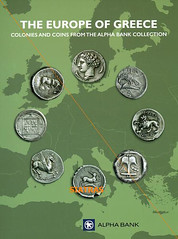 THE EUROPE OF GREECE: COLONIES AND COINS FROM THE ALPHA BANK COLLECTION
THE EUROPE OF GREECE: COLONIES AND COINS FROM THE ALPHA BANK COLLECTION
by D.Tsangari (ed.)
Exhibition catalogue. In english (also available in greek). Soft cover, 30 cm, 336 pp, ill.; net weight 1800 gr. EUR 56.00 + shipping cost
MAIN CONTENTS:
- Colonisation - The Oracle of Delphi
- The coinage of the colonies
[HISTORICAL DATA & COINAGE OF THE CITIES]:
- SOUTH ITALY: Heracleia, Hyele/Elea, Caulonia, Croton, Cyme, Laos, Epizephyrioi Locroi, Metapontion, Neapolis, Poseidonia, Rhegion, Sybaris, Taras, Terina, Thourioi
- SICILY: Acragas, Gela, Himera, Camarina, Catane, Leontinoi, Naxos, Selinous, Syracusae, Zankle, Lipara
- SOUTHWESTERN EUROPE: Massalia (Marseille, France), Emporion (Spain), hode (Roses, Spain)
- ILLYRIAN COASTS: Apollonia Illyrike, Epidamnos
- EUXINE PONTUS: Apollonia Pontike, Taurica, Istros, Callatis, Mesambria, Odessos, Olbia, Panticapaeon • Bibliography
ORDERS: Just send a message to siatras@hotmail.com
NEW BOOK: A CATALOG OF GEORGIAN COINS
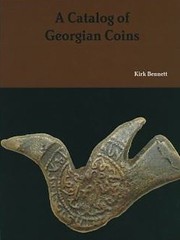 Bennett, K. A Catalog of Georgian Coins
Bennett, K. A Catalog of Georgian Coins
2014
341 pages
colour illustrations throughout
Casebound
Price £75
A useful English language guide to Georgian numismatics. The book aims to introduce English speaking readers to the wealth of knowledge available in Russian about the Georgian coinage, in this context, all coins struck in what is present-day Georgia. It aims to catalogue the types, varieties and dates of all the Georgian coins classified in the literature to date and to aid with identification and the reading of inscriptions on Georgian coins which are often in Arabic and Persian.
To read the complete article, see: A Catalog of Georgian Coins (www.baldwin.co.uk/a-catalog-of-georgian-coins.html)
NEW BOOK: ESSAYS IN HONOUR OF ROBERTO RUSSO
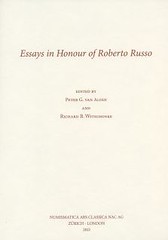 [Ed.] Van Alfen, Peter G. & Witschonke, Richard B.
[Ed.] Van Alfen, Peter G. & Witschonke, Richard B.
Essays in Honour of Roberto Russo
Numismatic Ars Classica. Zurich/London
2013
Large quarto
426 pages
black and white illustrations throughout
Casebound, jacket
Price £100
A work of fundamental new research on Greek and Roman republican numismatics. Superbly produced and containing a variety of important articles written by some of today’s greatest numismatists and scholars including; Keith Rutter, Christof Boehringer, Alberto Campana, Giovanni Santelli, John Morcom, Haim Gitler, David Vagi, Andrew Burnett, Andrew McCabe, Richard Schaefer, Andrea Pancotti, Roberto Russo, T.V. Buttrey, Richard Witschonke, Clive Stannard, Bernhard E. Woytek, Michel Amandry, Franc L. Kovacs and Lucia Travaini. A superb new reference containing a wealth of information, this is an essential reference for anyone with an interest in this area of numismatics as well as a great and fitting tribute to the late Robert Russo.
To read the complete article, see: Essays in Honour of Roberto Russo (www.baldwin.co.uk/essays-in-honour-of-roberto-russo.html)
NEW BOOK: THE HISTORY OF ISAAC NEWTON’S PAPERS
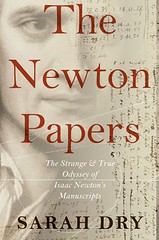 When Sir Isaac Newton died in 1727, he left behind no will and an enormous stack of papers. His surviving correspondences, notes, and manuscripts contain an estimated 10 million words, enough to fill up roughly 150 novel-length books. There are pages upon pages of scientific and mathematical brilliance. But there are also pages that reveal another side of Newton, a side his descendants tried to keep hidden from the public.
When Sir Isaac Newton died in 1727, he left behind no will and an enormous stack of papers. His surviving correspondences, notes, and manuscripts contain an estimated 10 million words, enough to fill up roughly 150 novel-length books. There are pages upon pages of scientific and mathematical brilliance. But there are also pages that reveal another side of Newton, a side his descendants tried to keep hidden from the public.
Even in his lifetime, Newton was hailed as an eminent scientist and mathematician of unparalleled genius. But Newton also studied alchemy and religion. He wrote a forensic analysis of the Bible in an effort to decode divine prophecies. He held unorthodox religious views, rejecting the doctrine of the Holy Trinity. After his death, Newton’s heir, John Conduitt, the husband of his half-niece Catherine Barton, feared that one of the fathers of the Enlightenment would be revealed as an obsessive heretic. And so for hundreds of years few people saw his work. It was only in the 1960s that some of Newton’s papers were widely published.
The story of Newton’s writing and how it has survived to the modern day is the subject of a new book, The Newton Papers: The Strange and True Odyssey of Isaac Newton’s Manuscripts . Author Sarah Dry traces their mysterious and precarious history and reveals both the lucky twists and purposeful turns that kept the papers safe.
WIRED: How much of Newton’s writing has survived?
Dry: A huge amount. There’s roughly 10 million words that Newton left. Around half of the writing is religious, and there are about 1 million words on alchemical material, most of which is copies of other people’s stuff. There are about 1 million words related to his work as Master of the Mint. And then roughly 3 million related to science and math.
WIRED: Did you read through all this work yourself?
Dry: [Laughs] The book isn’t really about the contents of the paper. It’s more about how others have made sense of all this work. And one of the messages of the book is that getting too involved in the papers can be hazardous to your health. One of the first editors of the papers said an older man should take up the task, because he’d have less to lose than a younger man.
To read the complete article, see: The Strange, Secret History of Isaac Newton’s Papers (www.wired.com/2014/05/newton-papers-q-and-a/)

COLUMBUS-AMERICA GROUP SUES ODYSSEY
(Norfolk, Virginia) -- Federal court motions claiming misappropriation and trespass were filed on Thursday, May 15, 2014, against a Florida salvage company by the Ohio-based group that first discovered and recovered Gold Rush-era sunken treasure from the S.S. Central America, the fabled "Ship of Gold" that sank in 1857.
Columbus-America Discovery Group (CADG) claims that Odyssey Marine Exploration, Inc. is in violation of the law. CADG is asking that U.S. Marshals immediately seize all the treasure recently salvaged by Odyssey from the Central America. The recovered items currently are in Charleston, South Carolina, according to the court motions.
The S.S. Central America, a 278-foot long sidewheel steamer, was sailing from Panama to New York City with tons of California Gold Rush-era coins and ingots when it sank in a hurricane on September 15, 1857. There were 447 passengers and 101 crew members; 425 of them died when the ship sank.
In addition to the human tragedy, the loss of the expected gold in New York led to the financial "Panic of 1857" that resulted in the closings of some banks and factories. A 1992 Life Magazine cover story proclaimed the recovered gold, "The greatest treasure ever found."
During a scientific expedition in 1987, CADG originally located the wreck site in the Atlantic Ocean about 160 nautical miles off the coast of South Carolina and subsequently recovered thousands of gold coins and hundreds of gold ingots. CADG claims it still has the exclusive rights to that site and any retrieved gold and artifacts. CADG wants the federal court to reassert the company's protected rights to any additional treasure found at the site.
The motions filed Thursday with the United States District Court, Eastern District of Virginia in Norfolk, Virginia, ask that federal marshals seize the latest items and any future items recovered by Odyssey and turn them over to CADG. The items are believed to still be on board the vessel OSV Odyssey Explorer now docked in Charleston, South Carolina, according to CADG's court filings.
"Columbus-America Discovery Group, which has done several previously impossible feats in the deep ocean and has been sued and challenged continuously for more than 20 years, is still fighting for its right to the deep ocean shipwreck site of the SS Central America," said Milt Butterworth, CADG President.
"We are asking the court to uphold our permanent injunction, and allow CADG to fulfill its original purpose: to conduct multi-disciplinary research and develop sophisticated deep-ocean technology, and to locate, explore, and recover the remains of the S.S. Central America.," Butterworth stated.
One of the court motions states: "On or about April 14th an expedition aboard the OSV ODYSSEY EXPLORER...intruded into the injuncted sea area without the Court’s knowledge and permission...."
The motion also states: "In order to protect its Court awarded rights and its maritime lien interest in any gold or artifacts recovered from the wreck of the S.S. CENTRAL AMERICA, it is imperative that CADG be authorized by the Court to have the U.S. Marshal execute a warrant in rem against these same artifacts...."
CADG claims that Recovery Limited Partnership and its contract-salvor Odyssey Marine Exploration "and any person aiding, abetting and/or assisting the violation of the rights and protections of CADG are interlopers, have engaged in acts of conversion, misappropriation of tangible and intellectual property rights, trespass, violation of CADG's injunctive, possessor, salvage and other rights, and have violated the permanent injunction."
An Odyssey Marine press release states that: "Recovery Limited Partnership (RLP) was organized in 1985 as an Ohio limited partnership to finance the SS Central America project. Columbus-American Discovery Group LLC (CADG), as agent for RLP, initiated an admiralty action in the United States District Court of the Eastern District of Virginia to establish ownership of the shipwreck and all of its contents. After more than a decade of litigation, the court ruled that CADG owned 92.5% of the recovered gold and issued permanent injunctions which prohibit any party other than CADG or RPL from operations related to the site." Odyssey Marine Exploration Selected for Recovery of SS Central America Gold (ir.odysseymarine.com/releasedetail.cfm?ReleaseID=829501).
So legally, CADG and RLP are different entities and are the only organizations permitted to salvage the site. One of them hired Odyssey to do just that, and now the other is suing.
To me the craziest thing about this is the "without the Court’s knowledge" part. Uh, this expedition has been in the newspapers and all over the 'net for weeks (the above press release was published March 3rd, and the Bloomberg article was nearly two months ago).
Bob Evans laid out the history for us in his April 21, 2013 E-Sylum article on the disposition of the treasure recovered in the 1980s. Every bit of the treasure was accounted for, documented, published and signed off on by the insurance companies in the early 1990s. The first lawsuits were from the Columbus-America investors seeking payment from Tommy Thompson, and there is an Ohio state court case against Thompson, who has been missing for years.
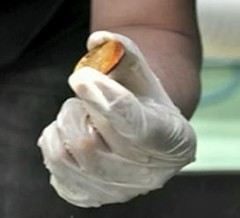 But there is also a Federal case, also brought against Thompson by the sonar company that was employed in the 1980s search, claiming they are also entitled to a share of the treasure.
But there is also a Federal case, also brought against Thompson by the sonar company that was employed in the 1980s search, claiming they are also entitled to a share of the treasure.
This May 16th Associated Press article sheds a little more light on the matter:
Columbus-America and its current president, Milt Butterworth, are now fighting to gain control over any recently recovered gold, stop the ongoing expedition and conduct any future trips to recover the gold.
Late last week, federal Judge Rebecca Beach Smith declined to rule which company has the rights to the sunken ship but did find that Odyssey Marine "is qualified to perform the ongoing salvage operation," ordering that it can continue doing so.
New fight emerges in Ohio treasure hunter dispute (www.chron.com/news/crime/article/New-fight-emerges-in-Ohio-treasure-hunter-dispute-5484158.php)
This whole thing gets messier and messier by the day. Hopefully there will be another nice numismatic haul come to market at some point, but the legal wrangling could tie things up for some time. I did manage to reach Bob Evans today and he provided the following statement. Thanks! -Editor
Bob Evans writes:
For my fellow numismatists,
Obviously, I cannot comment on the ongoing litigation covered in the stories and press releases now appearing. But I want my friends in the numismatic community to know that I intend to continue to be a force for good in the grand enterprise of which I am now a part. I am very pleased that I have resumed my role as chief scientist/historian for the exploration of the S.S. Central America shipwreck site.
I find myself once more at the point of first contact, discovering and identifying its numismatic and historical wonders as the treasure emerges from the deep. My colleagues aboard the RV Odyssey Explorer are world class, professional, attentive and careful. We are observing and recording with archaeological and scientific detail equal to or exceeding the achievements of twenty-plus years ago, with modern equipment and precision, and with all the respect that our important subject deserves. What results from this effort is and will be glorious.
My very best,
Bob Evans
To read earlier E-Sylum articles, see:
S.S. CENTRAL AMERICA CASE COMING TO TRIAL
(www.coinbooks.org/esylum_v14n22a15.html)
BOB EVANS ON THE DISPOSITION OF THE S.S. CENTRAL AMERICA TREASURE
(www.coinbooks.org/esylum_v16n16a32.html)
BOB EVANS ON THE LATEST S.S. CENTRAL AMERICA ARTICLE
(www.coinbooks.org/esylum_v16n19a26.html)
BOB EVANS SETS SAIL FOR THE S.S. CENTRAL AMERICA
(www.coinbooks.org/esylum_v17n18a06.html)
ODYSSEY SS CENTRAL AMERICA RECONNAISSANCE DIVE
(www.coinbooks.org/esylum_v17n20a13.html)
MICHAEL LORZ ON THE SS CENTRAL AMERICA LITIGATION
I’ve been enjoying The E-Sylum for years, and never had reason to communicate before, but the stakes are high right now for the SS Central America, and I would like to share some information with you and readers of this forum.
First, I want to introduce you and your readers to Milt Butterworth, new president of Columbus-America Discovery Group. And, with the hope that you will remove them, I also wish to point out several errors in the article you have indicated you will publish tonight.
I have enclosed a brief listing of the credentials of Milt Butterworth, president of Columbus-America Discovery Group. Milt configured the ROV Nemo to enable it to capture all the still photos and video from the shipwreck site of the SS Central America. He was in the control room for every recovery dive, and was a strong part of the leadership team of Columbus-America for two decades.
Also enclosed is a statement from Milt, carefully outlining a Brief History of Columbus-America Discovery Group.
Personally, I had the pleasure of meeting Milt shortly after Tommy Thompson asked me join Columbus-America to lead the internal team in design and installation of the 9000-square foot exhibit at Columbus Museum of Art in 1992. That exhibit was about “deep ocean images” of the discovery and recovery of the SS Central America. We worked next on a similar but larger exhibit at the Columbus Zoo and Aquarium in 1994, which focused on the many forms of deep ocean animals discovered at the shipwreck. Milt’s thorough and deep knowledge of the recovery phase, and public education phases inspired Tommy Thompson to make him manager of all Columbus-America staff for many years.
It is my hope that you and your readers will get to know Milt, and respect him for his knowledge of the SS Central America, and Columbus-America Discovery Group. I know that every member of the Columbus-America team holds him in the highest regard, both as a professional and a leader.
Lastly, I must point out several errors in the article you indicated you would publish tonight. The first inaccuracy is implied in your question: “Wasn’t Odyssey Marine working for Columbus-America Discovery Group, the original investment team that Tommy Thompson and Bob Evans sailed for?” No Wayne, Odyssey has contracted with Recovery Limited Partnership, under court-appointed receiver Ira Kane. Columbus-America Discovery Group was never a party to any of the litigation that led to the Ohio court appointing a receiver. Court documents I can provide will support this fact. Since it was not a party to the litigation, the receiver has no court-granted authority over Columbus-America, and Columbus-America is not involved in the at-sea operations being undertaken by RLP and Odyssey Marine.
Bloomberg News may have said “(Bob) Evans…will represent the original investors…” But RLP is the company involved with investors, not Columbus-America.
The next inaccuracy is in reprinting an inaccurate quote from an Odyssey Marine press release, which says in part: “the court…issued permanent injunctions which prohibit any party other than CADG and RLP from operations related to the site.” This is inaccurate because the court document about the permanent injunction does not mention RLP as being involved at all. I can provide that court document also.
The last point is the matter of how many investors brought the various legal proceedings in Columbus that prevented us from continuing our deep ocean mission. Court documents show that only 2 of nearly 300 investors have sued, which is less than 1% of the investors. I point out this seeming detail, because when the word “investors” is used regarding the lawsuits, your readers may quickly assume that is many, or most of the investors. It is not. It is 2 investors, one of which is Dispatch Printing Company, the largest and strongest media owner in Central Ohio, and the other, now deceased, was an individual retired from a financial company that was controlled by members of the same family that owns the Dispatch Printing Company.
The SS Central America represents an exciting story, one that has too long been tied up in courts. It is our hope that Columbus-America Discovery Group will soon be actively pursuing its mission, to protect the SS Central America site, to conduct multi-disciplinary deep ocean research, to recover the treasures of the SS Central America and tell its new stories, to pay the operating expenses it will incur, and distribute a return to its investors.
Sincerely
F. Michael Lorz,
For Columbus-America Discovery Group.
MORE ON HENRY BERGOS
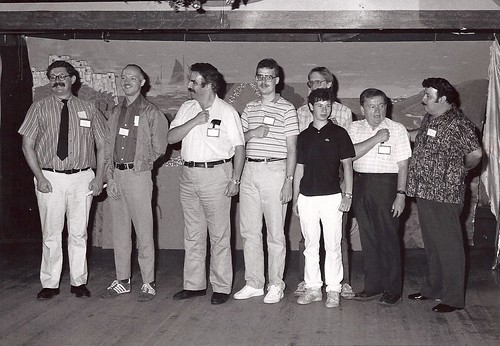
Bill Daehn writes:
I did not really know Henry personally, but in July 1987, I participated in the American Numismatic Association’s Summer Seminar on Ancient Roman Coinage, taught by Robert Hoge. Henry was one of the students in the class. At the end of the week, the seminar students took in a play, at the end of which we were called on stage for a “class photo.”
Those in the photo are (left to right): Robert Hoge (ANA Museum Curator at the time, and class instructor), Bill Mross, Henry Bergos, myself (Bill Daehn), Tim (last name unknown), Matt Zuckerman, Don Ottaway, and Larry Gentile. In the photo, we are giving instructor Hoge a “Roman salute.” If I remember correctly, that was Henry’s idea.
Bill Rosenblum writes:
I knew Henry from shows in NYC when there were 3 or 4 good ones there a year. The AINA shows, the old NY International on 7th Ave and the occasional GENA show and even the ANA once in a while. He was always good for a half-hour or more of conversation. We never did a great deal of business together but we bought and sold books to each other but probably very little of anything else.
I believe AINA halted their shows sometimes in the 90's and I stopped taking tables at the NY International when they moved to the Waldorf-Astoria after the 9/11 terror attack, so I guess I just thought I missed Henry rather than he wasn't around anymore. I vaguely remember him telling me once that he was moving down south. I just couldn't see it. To me Henry was a New Yorker, and more specifically a Brooklyn guy. Like so many people in our community he was one of a kind.
To read the earlier E=Sylum article, see: HENRY BERGOS (www.coinbooks.org/esylum_v17n20a08.html)
CASH IN YOUR COINS ... AND BOOKS!

In the upcoming second edition of Beth Deisher’s Cash In Your Coins: Selling the Rare Coins You’ve Inherited, we include a new photograph and caption illustrating an important concept: “Numismatic books can be valuable, too. Make an inventory of titles and copyright dates.” (This is in chapter 9, on creating an estate inventory.)
I took one of our staff photographers into the Whitman Publishing library to get a photo of the concept. He took a picture of several early-1900s bound volumes of The Numismatist, Evans’s Illustrated history of the U.S. Mint, a copy of Bowers’s Collecting Rare Coins for Profit, and a couple world-coin books (Monnaies Francaises and Welt Munzkatalog).
To read the earlier E-Sylum article, see: NEW BOOK: CASH IN YOUR COINS (www.coinbooks.org/esylum_v16n27a04.html)
NOTES FROM E-SYLUM READERS: MAY 18, 2014
Corrections to the May 11, 2014 Issue Last week's article on the John Burns Memorial dinner was well received and widely circulated. CoinWeek picked it up for their E-Sylum article of the week. It was a great event and much fun was had by all. But I have two name corrections, and apologize for my mistakes; the correct spellings are Dianne Deep and Chris Komondy. Also, in the article on Coin Design Competitions, “Weinman dime and haft dollar” should be “... half dollar” (thanks to Ken Spindler for catching this one).
To read the earlier E-Sylum articles, see:
WAYNE'S NUMISMATIC DIARY: MAY 11, 2014
(www.coinbooks.org/esylum_v17n20a15.html)
COIN DESIGN COMPETITIONS
(www.coinbooks.org/esylum_v17n20a33.html)
More on Consimilar Alan Luedeking writes:
Consimilar: Who needs it, if 'identical' is consimilar?
Fred Michaelson writes:
I must admit that I don't remember ever encountering the word "consimilar," but I'm surprised that Webster would use such a redundancy in defining it: "having a common resemblance." (not to mention Merriam-Webster's "sharing in similarity.") The concept of "common" is already contained in the word "resemblance," as that of "sharing" is contained in the word "similarity." Whoever Collins is, he's got the others beat on this one.
Larry Dziubek writes:
Duane Feisel uses the word BIFACIAL in his auctions when describing a token that has an obverse and reverse that are alike.
I asked Duane Feisel, who writes:
Typically I wouldn’t use “bifacial” or “consimilar” but I think a consignor had used bifacial to describe his token, and I just used it in the auction listing. Normally I just use (same) or (same as obverse) for the reverse when O&R are identical. That is easy to understand! I have never used consimilar. Where space is not at a premium as in my catalogues, I do use “same as obverse”, sometimes modified as (same as obverse, no signature line).
bi•fa•cial (bī-fā′shəl)
adj.
1. Having two faces, fronts, or façades.
2. Having two opposing surfaces that are alike.
3. Archaeology Flaked in such a way as to produce a cutting edge that is sharp on both sides. Used of a stone tool.
To read the earlier E-Sylum article, see: VOCABULARY WORD: CONSIMILAR (www.coinbooks.org/esylum_v17n20a20.html)
Eric Newman's Tenacity Regarding the upcoming research article from Eric Newman, Anne Bentley writes:
When I grow up, I want to be just as active and involved as Eric is!!! Looking forward to the article this summer!
In the Colonial Coins Forum, Ray Williams wrote about being at this week's heritage Newman colonial coin auction in New York:
I saw many friends there and the socializing was as much fun as the auction itself. Being there in person, the auction seemed to run smoothly with only one minor internet delay. Eric Newman's son was there. I told him what an influence Eric has been to me and how his research and sharing of knowledge has added to the hobby for generations to come.
At the break, there was a birthday cake for Eric, who will be 103 this month! Eric wrote a stanza of a poem for his son to read to those present. It was very nice and funny too. The cake had Eric's image on top - just like the catalog cover. Now... usually those cakes are good for looking at, but this one was delicious!!!
To read the earlier E-Sylum article, see:
ERIC NEWMAN'S LATEST CONTINENTAL CURRENCY DOLLAR RESEARCH
(www.coinbooks.org/esylum_v17n20a04.html)

A Fishy Medal By Van Dionant Here's an interesting medal your Editor found while surfing eBay this week.
To read the complete eBay lot, see:
Belgium. AQUARIUM FISH. By Van Dionant.
(www.ebay.com/itm/Belgium-AQUARIUM-FISH-By-Van-Dionant-/151302086186)
1988 GEORGE FREDERICK KOLBE GOOD-FOR TOKEN
Jeremy Milligan writes:Here are a couple of photos I just took of my new Kolbe trade token. Can anyone provide info about it?

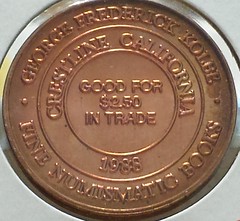
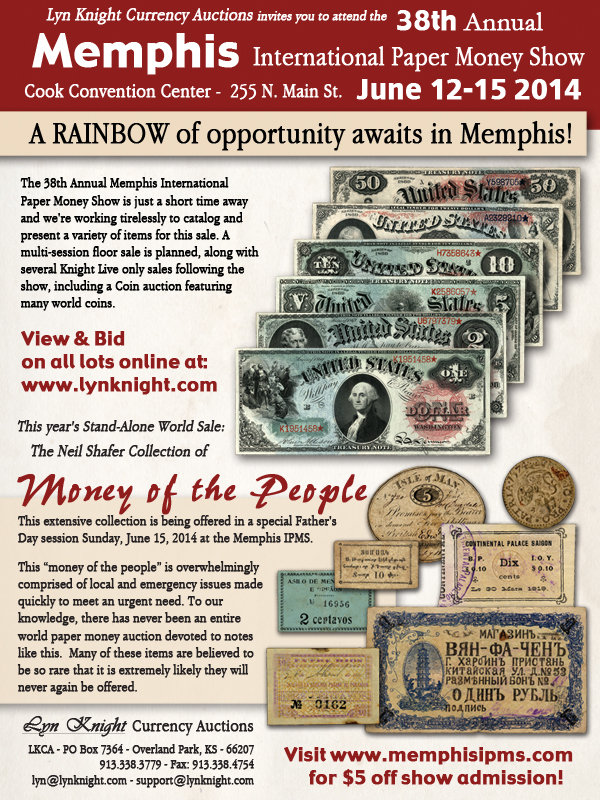
AN APPROACH FOR CATALOGUING PRISON SCRIP
A Proposed Revised Cataloguing Approach for Prison Scrip
By Bob Hewey
 While Jerry Zara, in his 1992 book entitled Prison Tokens and Medals of the United States, has done a great service to the collectors of prison money, I believe his numbering system leaves something to be desired. He simply uses a two letter State identifier followed by a sequential number, interspacing a few numbers between series for new additions, should they be found.
While Jerry Zara, in his 1992 book entitled Prison Tokens and Medals of the United States, has done a great service to the collectors of prison money, I believe his numbering system leaves something to be desired. He simply uses a two letter State identifier followed by a sequential number, interspacing a few numbers between series for new additions, should they be found.
To research an alternative to this approach, I looked at The American Vectorist Association volumes on transportation, parking and carwash tokens, Alpert’s Catalogue of Charge Coins and other similar volumes as well as the standard Yeoman and Krause coin standard catalogs. None of these approaches seemed satisfactory to me.
I propose a new approach, identifying the state, facility, type of scrip, series identifier, denomination or use, and subtype identifier as follows:
State: Two Alpha State Identifier (e.g. AK = Alaska)
Facility: Three Alpha Facility Identifier (e.g. TSF = Tucker State Farm)
Type of Scrip: B=Coupon Book/Card, C=Coupon/ticket, P=Punch Card, T=Token, N=Note
Series: One Alpha Identifier of a group of a similar type of scrip (A through Z)
Denomination/Use: Three Characters (e.g. 001 = one cent, 100 = $1, $10 = $10, LAU = Laundry, SHW = Show, GEN = Generic)
Subtype: One lower case alpha to identify die variations within a type.
While this approach may seem cumbersome, I believe it provides the necessary flexibility to properly catalog current and future prison money types.
Some examples:
1. Zara’s Catalog Numbers AR-50 to AR-54 for Tucker State Farm would become: AR-TSF-T-A005, AR-TSF-T-A010, AR-TSF-T-A025, AR-TSF-T-A050, AR-TSF-T-A100.
2. Zara’s Allegheny County Jail Scrip tickets PA-1 to PA-7 would become: PA-ALL-C-A001, PA-ALL-C-A002, PA-ALL-C-A005, PA-ALL-C-A010, PA-ALL-C-A025, PA-ALL-C-A050, PA-ALL-C-A100, and the books containing these tickets, which are not identified in Zara would become: PA-ALL-B-A500, PA-ALL-B-A$10, PA-ALL-B-A$15, PA-ALL-B-A$20.
3. Zara’s punch card NH-1 would become NH-STP-P-A050.
4. Zara’s NY-20 and NY-21 would become NY-SNG-T-A025a and NY-SNG-T-A025b
It is my intention to publish a revised Prison Scrip Catalog and would welcome information on items unlisted in Zara’s book as well as comments on my proposed numbering system. You may send your suggestions, comments and information to boltonbob@aol.com.

THE CARDBOARD TOKENS OF G. H. KENT
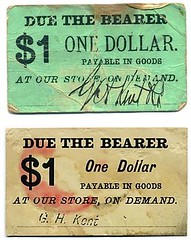 For many long-gone Virginia general stores, all that remains of their history are their tokens and perhaps a few pieces of ephemera here and there. The history of the G. H. Kent store in Fluvanna County, Virginia is thankfully an exception. The tokens used by G. H. Kent reveal two different phases of his businesses, the first as proprietor of a general mercantile and then as a druggist.
For many long-gone Virginia general stores, all that remains of their history are their tokens and perhaps a few pieces of ephemera here and there. The history of the G. H. Kent store in Fluvanna County, Virginia is thankfully an exception. The tokens used by G. H. Kent reveal two different phases of his businesses, the first as proprietor of a general mercantile and then as a druggist.
The first store building was a large two story false front structure with a large main room with the post office located on the eastern side. Also on the first floor were separate rooms for crockery and shoes, plus bedrooms for the clerks and a counting room. The drug department was located at the back. Men’s clothing was displayed on the second floor. An outbuilding housed dry goods such as hardware and flour and even caskets. Kent used tokens, which were referred to as “due bills”, as way to extend credit to his customers, many of whom would sell their produce to Kent.
In 1906, Kent purchased the remaining stock of drugs and continued as a druggist in the old two story furniture building nearby. The records for the store still exist and currently reside at the Virginia Tech Library’s Special Collections. According to the business journals, even though Kent & Parrish ceased to operate under that name, account settlements did not complete until 1899. In addition, even though the trusteeship ended in 1906, the accounts were not fully settled until 1910. Kent died on November 16, 1936 and the drug store he ran for decades continued to operate at least until 1947.
A third store building, this time made of cinderblock, was built sometime in the 1940s or 1950s across the street from Kent’s drug store, and continued as a local general store with a small hot dog stand in the back until very recently. That building, adjacent to the Fluvanna County Volunteer Fire Department, is now used as a woodworking shop, and remains a center of community activity.
The tokens used by G. H. Kent were all round cardboard tokens 36 mm in diameter, using blanks ordered from Cussons, May & Sheppard in Glen Allen, Virginia. These blanks were then either filled in by hand or stamped with rubber stamps.
There are four basic types of Kent tokens: G. H. Kent & Co. handwritten, stamped G. H. KENT (in all caps), stamped G. H. Kent in mixed case italic, and the round KENT’S STORE, VA / M. O. B. postal marking. Denominations used include 1¢, 2¢, 5¢, 10¢, 25¢, and 50¢. Even though Cussons, May & Sheppard produced round tokens in $1 and higher denominations, Kent used rectangular card stock chits for $1.
The card stock chits are known in two varieties, a green colored chit with “G. H. Kent & Co.” handwritten and a cream colored chit bearing the italic G. H. Kent stamp. The earliest tokens are usually in fair to poor condition when found, while most of the later G. H. Kent & Kents Store stamped pieces are more frequently available and usually in high grade.
The hand stamps used to produce the tokens are still extant and tell an interesting story of the transition from the period from G. H. Kent & Co. through its trusteeship and into the 1930s.
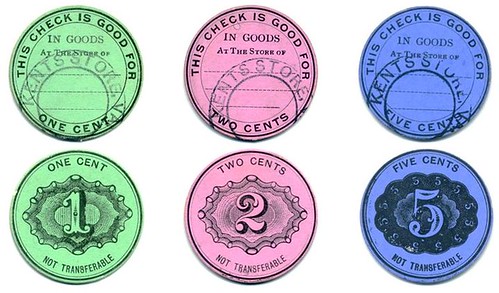
For more information on the Token and Medal Society, see: www.tokenandmedal.org
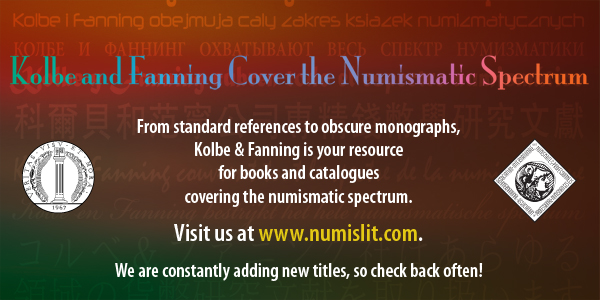
MORE ON THE RETAIL COIN DEALERS ASSOCIATION
 Google Books lists a 44-page item titled
"Retail Coin Dealers Association Convention: June 4, 5, 6, 7, 1964 : Riverside Hotel, Reno, Nevada" It lists the authors as Hank Bieciuk, Inc, Northen Nevada Numismatic Association. But it doesn't actually have the content of the book (which sounds like a convention program). An internet search for the authors turned up no more information.
Google Books lists a 44-page item titled
"Retail Coin Dealers Association Convention: June 4, 5, 6, 7, 1964 : Riverside Hotel, Reno, Nevada" It lists the authors as Hank Bieciuk, Inc, Northen Nevada Numismatic Association. But it doesn't actually have the content of the book (which sounds like a convention program). An internet search for the authors turned up no more information.
An eBay auction has an example of the same token/medal that Alan Roy illustrated in his query last week: 1960 RCDA Retail Coin Dealers Association Copper-Bronze Coin-Token (www.ebay.com/itm/1960-RCDA-Retail-Coin-Dealers-Association-Copper-Bronze-Coin-Token-/201050760918)
Another Google Books search turned up a reference in the November 1984 issue of The Rotarian, the magazine of the Rotary International organization. It's found in a coin ad for "The Numismatic Guild" of New York. The headline is "We're selling a 3-Piece, $100 Solid Silver Dollar set for only $69... and you get an extra silver dollar FREE with each set ordered within 30 days!" The ad brags that "The Numismatic Guild, dealers in rare coins for over 35 years, is a member of the prestigious Retail Coin Dealers Association and our president is a lifetime member of the American Numismatic Association."
The Professional Numismatists Guild (PNG) web site states it was founded in 1955. Why two coin dealer associations? There's probably some interesting history behind this. Can anyone help? -Editor
To visit the Professional Numismatists Guild web site, see: www.pngdealers.org
To read the earlier E-Sylum article, see: QUERY: RETAIL COIN DEALERS ASSOCIATION (www.coinbooks.org/esylum_v17n20a17.html)
GENE & TOM'S NUMISMATIC DIARY: MAY 18, 2014
Aaron Packard was the host. He picked one of his favorite hangouts, Southside 815 Restaurant in Alexandria, VA. Since I wasn't there to tell the tale, Gene Brandenburg and Tom Kays have picked up the slack. Here are their accounts of the evening - first Gene. -Editor
The restaurant was a pleasant surprise, old dark wood English pub-like with a warm (and cute) wait staff. The food was hearty and well prepared - and reasonable. They offered a small but well thought out wine & beverage list, several bottles of a quite good Australian shiraz bit the dust (Dave, Eric, Tom & Jon helped out - it's nice to have trusting friends around in a pinch). This place needs to be revisited.
Quite good 'show and tell' with some rarities. Tom Kays outdid himself again, he's almost a mobile numismatic museum. Dave brought some rare paper including a unique mining note from Elyria, Ohio. There is a rather well known collector in the D.C. area from Elyria with a reputation for being - well 'annoyingly excessively frugal' may be an understatement. Fun & games are being planned - paybacks can be hell.
Julian Leidman worked the room, shaking hands. It's good to see this quite busy dealer take the time out to attend. His sage advice (he OK'd a suspicious 1877 cent for someone), good humor and great stories help make Nummis Nova what it is. There's hundreds of years of numismatic experience at these dinners and the stories are memorable. Giggling with the older guys about some of the truly goofy dealers & collectors we've known is well, just flat damn fun.
Executive Summary - We supped and drank, swapped coin stories and went home happy.
More Details – Nummis Nova convened at Southside 815 on South Washington Street (Home of Southern Classic Cuisine) in Old Town Alexandria on Tuesday last. Some arrived steaming after a two and a half hour Beltway commute, badly needing the comfortable and relaxed atmosphere at the restaurant to unclench fingers long held in the death-grip position around steering wheels doing little actual steering. E-Sylum’s fearless leader, Wayne H. (#1) went missing due to his son’s basketball playoff, demonstrating well-rounded leisure pursuits beyond “numismania” as they used to call it.
Last week Wayne H. (#1) was cracking safes, cleaning estates, and auctioning coin books for a friend in Western Pennsylvania, and next week Juno Moneta only knows where the next Numismatic Diary will originate. We in coin society must stand in awe of Wayne’s multitasking abilities and weekly editorial accomplishments bringing you yet another dandy E-Sylum. Nummis Nova boasts a numerous enough quorum to occupy a very long dinner table that typically divides into distinct “conversation zones” hither and yon. I sat “hither” near Gene B., Dave S., “Q” Eric S., Jon R., and newcomer Joe R., who is Jon’s son, an ANA member, trusted assistant at the Annandale Coin Show Kid’s Event, and middle-schooler, who collects “weird” coins. Boy was he seated at the right table for that!
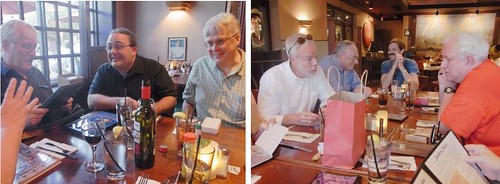
Pictured Left-to-Right: Hither Zone with Gene (talk to the hand), Dave, Eric, and Jon / Yonder Zone with Chris, Joe, Wayne H (#2) and Steve
The “yonder” conversation zone, beyond my earshot included Aaron P., Steve B., Julian L., Wayne H. (#2), Joe L., Chris N., and Lenny G. No telling what they actually said about folks in the “hither zone” but I have it on good authority much of their evening was spent ratting out good from bad customers who do / don’t pay for coin purchases without some delay or grief like IOUs, rubber checks, or bill-me-later-catch-me-if-you-can plans. All the trouble-makers tend to be well known “friends” of coin dealers, while strangers invariably provide prompt and sterling payment. Why is that? Does familiarity breed deadbeats? It’s a head scratcher.
Passing by in review, well before our main course (I recommend the red beans and rice with smoked kielbasa on special) were one of the (800 of 1500 printed) EAC Grading Guides released at the EAC/C4 convention and signed by Bill Eckberg (author and half cent mogul), and a token celebrating Eric Newman’s birthday (his 103rd).

Pictured Left: Unique? W.H.Baumgardner Dairy Token, circa 1880s and Right: 2014 Proof Baseball Dollar fresh from the Mint
Numismatic “weirdness” (our de facto theme for the evening?) began building with a supposed unique W.H. Baumgardner Dairy Token for One Pint Milk, with Longhorn reverse (do any readers have another example?), a fine collection of Grand Army of the Republic (GAR) encampment badges, a 1792 Barbados half penny token, a small group of leather bill folds and wallets dating back to about Andrew Jackson’s presidency including a tri-fold for New York State with eagle on globe motif (similar to Pre-Mexican War, NY State Militia, one-piece uniform buttons styled similar to Albert NY-7 through NY-16 in his “Button Book”) with marbled end papers, and an early U.S. Navy (Eagle with anchor on slanted oval shield) bi-fold, bill fold.
Also seen were a beautiful slabbed and toned, 1796 silver dollar, grading at least extra fine, a Ferran Zerbe Advertising “C-Note” (When U want 2 Buy, Sell or Obtain Information on Coins, Paper Money, curios, or Souvenirs Write Farran Zerbe – The Expo Souvenir Man – Tyrone PA), a token for S.H. Quint and Sons, Medalists of Philadelphia, an 1860s Norfolk, VA token for R. Chamberlaine in white metal by Bolen with George Washington reverse of which just five were struck, a 2014 Baseball Commemorative Dollar in proof (neat convex/concave coin) on sale now from the U.S. Mint, several Russian Kopeck Novodels, including a 1796 cipher-style, an unearthed 1787 Nova Eborac copper, and many other R-7, R-8 and R-9 trade tokens (such as a “Good for Ten Cents” aluminum token for Ivey E. Futch of Lake Placid, FL and several varieties of Weil and Levi Tokens of San Francisco), a stack of obsolete bank notes of Ohio including a rare note from a certain coin collector’s home town which has yet to be discussed, and yes, other coins of nearly indescribable “weirdness” to the delight of young Joe, such as a modern carving in the style of the Hobo Nickel in tribute to the art on ancient coins with a fine visage of “Minerva.” Weird coins we got.

Pictured Left: One of multiple embossed cartouches of Eagle on Globe on leather “Excelsior” Tri-fold New York State Document/Bill Fold; Pictured Center: Early U.S. Navy cartouche on Bi-fold wallet; and Pictured Right and far Right: “Minerva” styled after Athena in crested Corinthian Helmet as found on ancient Greek silver, but carved as a “Hobo Nickel” on a 1916-Denver Mint Buffalo, done by master carver “AC” for Alan Chernomashentsev, a pleasing tribute to the numismatic arts spanning millennia.
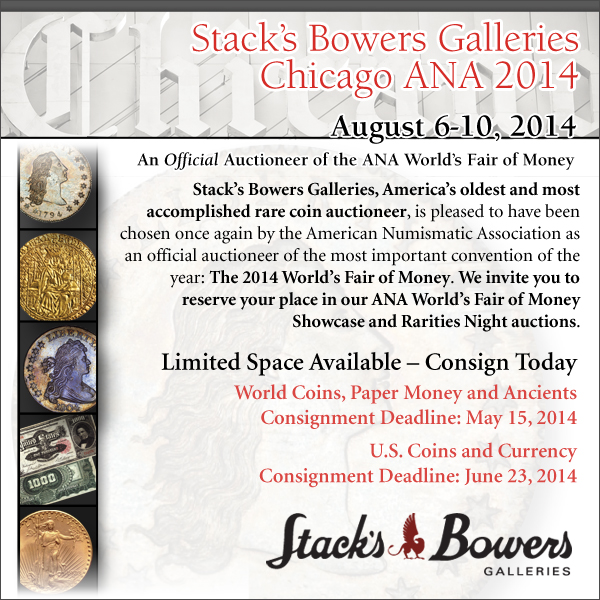
FLIGHT 93 FALLEN HEROES OF 9/11 MEDAL DESIGNS
Over the Easter holiday family members visited from Pittsburgh and one afternoon some of us went to the Pentagon 911 Memorial. I'd recommend it to anyone visiting the Washington, D.C. area. It's somber, well-executed and very appropriate memorial to the victims of American Airlines Flight 77 during the September 11, 2001 attacks. The Memorial was dedicated and opened to the public on September 11, 2008. From Wikipedia:
To honor the 184 victims, 184 illuminated benches have been arranged according to the victim's ages, starting with Dana Falkenberg, 3, to John Yamnicky Sr., 71, in a landscaped 1.93-acre (7,800 m2) plot. Each bench is engraved with the name of a victim. The benches representing the victims that were inside the Pentagon are arranged so those reading the names will face the Pentagon's south facade, where the plane hit; benches dedicated to victims aboard the plane are arranged so that those reading the engraved name will be facing skyward along the path the plane traveled. If more than one member of a family died during the attack, family names are listed in the reflecting pool under the bench, in addition to the separate benches that have been created for each individual.
Last Thursday, on my drive to Pittsburgh to help with the John Burns estate, I passed signs for the Flight 93 memorial in Shanksville, PA, honoring the 40 passengers and crew aboard the plane who resisted the hijacking and thwarted an attack on the U.S. Capitol. I've always wanted to take my family there and probably still will someday.
Like most of us who were adults on that day, it's an event we'll never forget. I was working on the 31st floor of the U.S. Steel building in Pittsburgh when a co-worker summoned me to a TV screen after the first plane hit the World Trade Center. When the second tower was hit, a lyric from Talking Heads popped into my brain - "heard about Houston, heard about Detroit, heard about Pittsburgh PA." It was Life During Wartime.
After gathering my wits I gathered my things and began to leave. Another co-worker asked if I heard we were being told to go home. Although I hadn't said it, I was thinking that as the tallest building between New York and Chicago, we could well be a secondary target, if not a primary one. For all we knew, another hijacked plane could be going past Pittsburgh right then. I didn't need to be told.
As it turned out, Flight 93 had been turned around and flown right past downtown Pittsburgh. I later learned that a jet had been scrambled with orders to halt the flight at all costs. The jet was armed with blanks for a training run, meaning the pilot and her copilot were on a suicide mission. They didn't make it in time and lived to tell the tale, but the passengers carried out the mission for them. While we will never know how the events unfolded, the plane never made it to its target. I stepped into a bar on the way back to my car and watched images of the flaming wreck of Flight 93 on that field in Shanksville, PA.
I knew about the U.S. Mint medal used to help fund the National 9/11 Memorial and Museum near the former World Trade Center site in New York. But I wondered if there would be separate medals for the four aircraft. Had I been following recent numismatic legislation I would have known such medals were in the pipeline. [So that's why you all should read Coin World and the great work of the writers there who follow this beat for a living.]
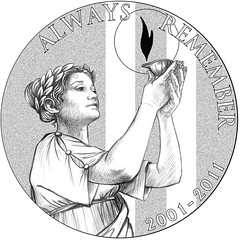
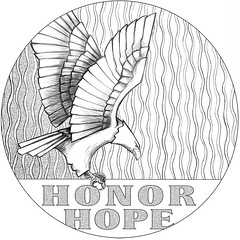
September 11 Memorial & Museum Commemorative Medal designs
So what do you know - this week my inbox began filling up with emails from the U.S. Mint with candidate designs for the "Fallen Heroes of 9/11" Congressional Gold medals. The first set were designs for Flight 93. Here are a few I'd like to share.
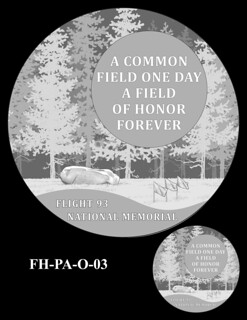
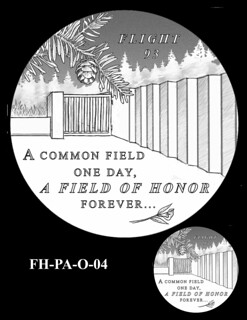
I like the tranquil scene on the left; the memorial wall, less so.
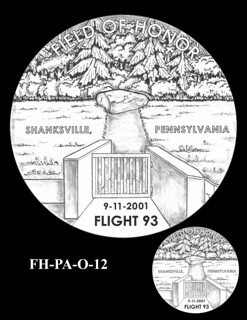
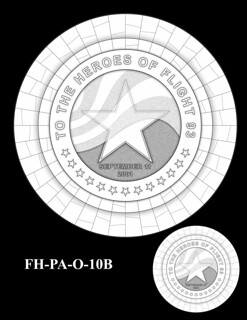
I hate to say this, but the walkway and rock could be seen as a phallic image. I don’t think it works. And the design on the right I don't get. I get that there are 40 compartment around the edge, one for each of the victims. But it's so plain it feels like there's no there there.
Here are a couple reverse designs.
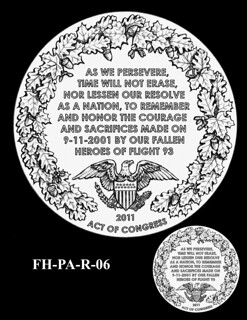

Both of these made me choke up, but the one on the left is too wordy for my taste. The one on the right is absolutely gorgeous and somber at the same time. I've never seen an image of an angel in flight like this, and to me it symbolizes the goodness and resolve of the doomed passengers, Hands down, this is my favorite. Wow.
For more information, see:
Pentagon Memorial
(en.wikipedia.org/wiki/Pentagon_Memorial)
A common field one day. A field of honor forever.
(www.nps.gov/FLNI)
U.S. MINT PRODUCES MEDALS FOR 10TH ANNIVERSARY OF SEPTEMBER 11
(www.coinbooks.org/esylum_v14n25a07.html)
F-16 pilot was ready to give her life on Sept. 11
(www.washingtonpost.com/local/f-16-pilot-was-ready-to-give-her-life-on-sept-11/2011/09/06/gIQAMpcODK_story.html)
NEW YORK FALLEN HEROES OF 9/11 MEDAL DESIGNS
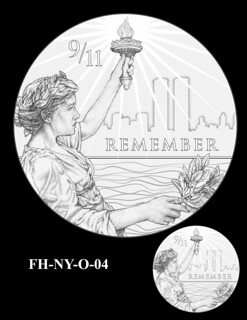
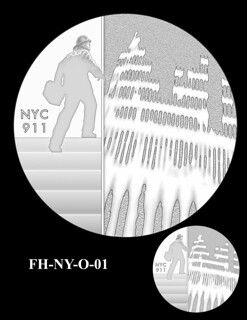
I think I like the one on the left even though it closely mimics the earlier 9/11 memorial medal. But I don’t think the ghost outline of the city works. The design on the right is ghostly as well and I get it, but I still don't like it.
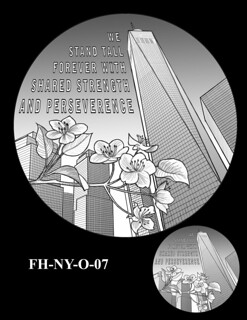
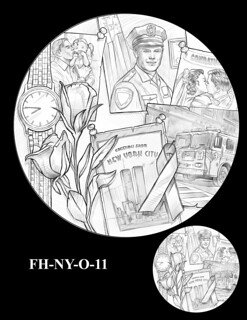
I like that the one on the left pictures the new office tower on the site, although I think the wording is superfluous - the image says it all. I like this the best of the proposed designs - I think it makes a good bookend to the earlier medal, kind of a before/after pair. As for the one of the right, I get the sentiment expressed by the photo collage left by loved ones at the site, but the motif just doesn’t work on a coin - it's too busy and crowded.
Here are a couple reverse designs.


What were they THINKING with the one on the left - yikes! The one on the right I like a lot. The pair of candles eloquently evokes the Twin Towers, and the policeman's and fireman's helmets are an understated representation of the fallen first responders. The wreath may be a little too busy, but overall I think the design works well.
MARCH OF DIMES COIN DESIGNS

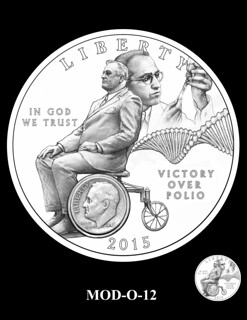
The one on the left is my favorite. The empty wheelchair with a child walking away aptly illustrates the outcome, a near total victory over polio. I remember thinking, "Hey, wouldn't it be really cool to use the Roosevelt Dime as one of the wheelchair wheels!" The design on the right shows why that's not such a good idea. It looks like FDR is sitting on his own head.
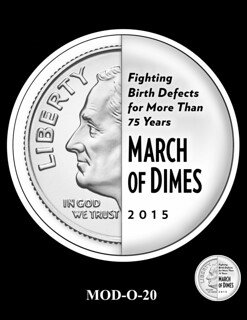
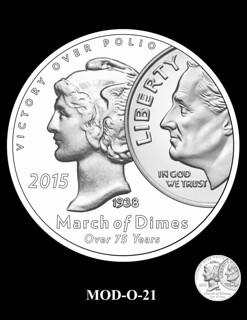
I give the one on the left style points even though I don't like it. The design evokes the slot people placed their dimes in to donate to the cause. The one on the right works better, I think, and has the bonus of being a double numismatic design,
THE BOOK BAZARRE
PREHISTORIC ART IN NUMISMATICS
Last week Bill Hyder suggested extending our list of cave painting art in numismatics to the larger field of prehistoric art. Here are some examples.
George Cuhaj writes:
Here is a 2010 commemorative from Palau, featuring Easter Island. It is part of a much larger set of coins which feature Wonders of the World.
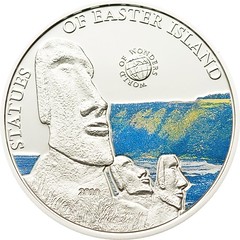
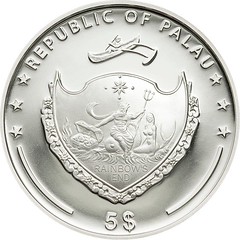
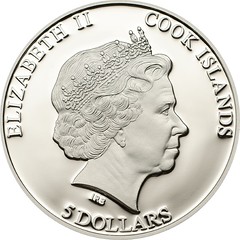
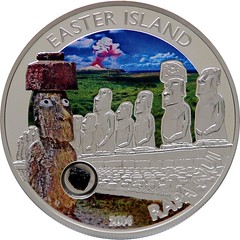
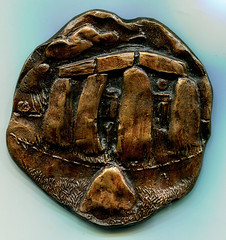

To read the earlier E-Sylum article, see: MORE CAVE PAINTING ART IN NUMISMATICS (www.coinbooks.org/esylum_v17n20a19.html)
THE BOOK BAZARRE
COINS OF THE VANDALS

Copper 42 nummi coin showing a Vandal warrior. Although it does not carry a king’s name, it is possible that this coin was made during the time of Gelimer (AD 530-3), and thus he may be the intended identity of the cloaked figure with a spear. The reverse shows the mark of value in Roman numerals (including the long-tailed L (=50) typical of Latin inscriptions in Vandal Africa, and also seen on Gelimer’s silver coinage). Above is the fine image of a horse’s head, the traditional emblem of Carthage since Punic times
The name of the Vandals is synonymous today with wanton violence and destruction. But it seems to me that, just like the Vikings, the Vandals have suffered from a bad press. The surviving accounts of their sack of Rome in AD 455, of their further piratical raids around the Mediterranean, and of their persecution of the Catholic inhabitants of North Africa are all presented through the eyes of their enemies and opponents: the Roman and Byzantine Empires and the established Church. Clearly, the Vandals were regarded as the ‘bad guys’ of the day and we, too have been led into thinking of them as wild barbarians, intent on the destruction of Rome and its civilisation.
But how balanced a picture do we get from the contemporary accounts? We do not, after all, have the Vandal side of the story, although we should probably discount the suggestion that they were invited into North Africa, their final home, in support of the Roman governor. He may have been made a scapegoat later for the Vandal conquest of the region.
The sack of Rome certainly did the Vandals no favours. Although their main aim was to seize treasures, they also took thousands of Romans captive. But, in spite of the political upheaval caused by the establishment of their kingdom, the region of North Africa that had fallen under their control remained prosperous and economically stable, even if at a reduced level. The Vandal kings minted coins of silver and bronze for trade, although this suffered to some extent following the decline of the market of Rome after 455.

To read the complete article, see: The Vandals: victims of a bad press? (blog.britishmuseum.org/2014/05/15/the-vandals-victims-of-a-bad-press/)
JOUSTING IN NUMISMATICS

Guldengroschen of Sigismund of Austria
Between 1431 and 1449, the Council of Basel attracted many powerful delegates to the city at the Rhine knee. Now and then, congress visitors want to be entertained (especially if the congress lasts several years). Hence many delegates made use of the opportunity to visit the fairly nearby city of Schaffhausen, venue of a large tournament between 1436 and 1438.
Among the away fans were two Spaniards. They left extensive written records to the posterity so that the tournaments of Schaffhausen are the best documented joustings we know of. Reason enough for Dr. h.c. Peter Jezler, director of the Museum zu Allerheiligen, to host an exhibition on the topic. And once again, he has done an excellent job. The visitor truly undertakes a journey into the past and selected objects create an authentic experience of what it was like to attend a tourney in this epoch.
You’re asking why this would be relevant for a numismatist? Well, quite simply, because numerous coins from the Early Modern Period portray rulers in shiny armour. If you ever wondered why princes and dukes still presented themselves in heavy, terribly uncomfortable armour at a time when wars were won by canons, not swords, the answer is that the portraits didn’t symbolise military leadership, but athletic prowess.
Take the famous guldengroschen of Sigismund of Austria. On the reverse, he presents himself on horseback and with crested helmet, entering the tourney.
To read the complete article, see: Of knights in shining armour – exhibition in Schaffhausen (www.coinsweekly.com/en/News/4?&id=2773)
BINI BOOK OF 1891 CHILEAN REVOLUTION NOTES
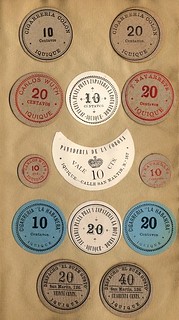 Rafael Bini was a printer in Iquique, Chile, who produced many local and bank issues during the Revolution of 1891. Perhaps as sales devices, or possibly just for friends, he put together a number of sample books of various pieces he had made during 1891. The books are basically similar but they differ in the exact issues contained. This difference was caused by the availability, or lack thereof, of certain of his issues as examples to place in the book.
Rafael Bini was a printer in Iquique, Chile, who produced many local and bank issues during the Revolution of 1891. Perhaps as sales devices, or possibly just for friends, he put together a number of sample books of various pieces he had made during 1891. The books are basically similar but they differ in the exact issues contained. This difference was caused by the availability, or lack thereof, of certain of his issues as examples to place in the book.
Size is 6 by 10 inches. I have it on good authority that there are less than half a dozen of Bini s books still in existence. This book has 57 pages, many of them full of Bini s products. Most even numbered pages are blank, so those numbers are skipped in page descriptions. Also, quite a few pieces made by Bini are included in various lots being offered today.
The book contains a number of issues not known otherwise and not in the following lots. This book is also the sole source of listings for the Banco de Tarapaca y Londres 1891 (Standard Catalog #S453-S455) and Banco de Valparaiso two types of 5 Pesos 1891 (#S511 and S512). All of these pieces were issued at Pisagua. Cardboard disks in the book come in two sizes: large (40 mm) and small (25 mm).
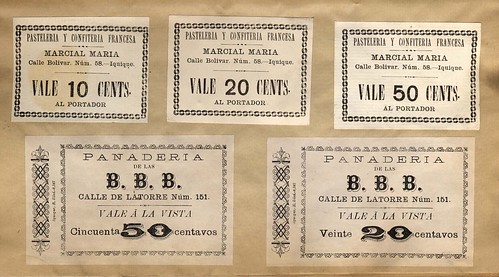
To read the complete lot description, see: Bini book of notes (www.lynknight.com/ShowAuctionDetails.Asp?auction_Id=229439)
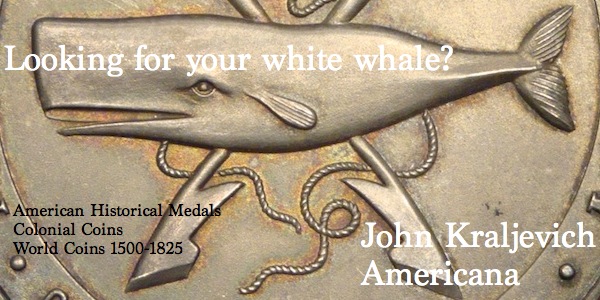
RICHARD LISSNER WORLD COIN COLLECTION SALE
 LANCASTER, PA–Classical Numismatic Group, Inc., of Lancaster, Pennsylvania and London, England, and St. James’s Auctions Ltd. (Knightsbridge Coins), of London, England, in association with M. Louis Teller of Encino, California, are pleased to announce the sale of The Collection of an American Connoisseur, Richard L. Lissner. The Lissner Collection features coins of the world, primarily type coins of the 19th and 20th centuries, and will be sold in two day-long sessions on 1-2 August 2014 at the Chicago Marriott O’Hare, just prior to the annual summer convention of the American Numismatic Association in Rosemont, Illinois.
LANCASTER, PA–Classical Numismatic Group, Inc., of Lancaster, Pennsylvania and London, England, and St. James’s Auctions Ltd. (Knightsbridge Coins), of London, England, in association with M. Louis Teller of Encino, California, are pleased to announce the sale of The Collection of an American Connoisseur, Richard L. Lissner. The Lissner Collection features coins of the world, primarily type coins of the 19th and 20th centuries, and will be sold in two day-long sessions on 1-2 August 2014 at the Chicago Marriott O’Hare, just prior to the annual summer convention of the American Numismatic Association in Rosemont, Illinois.
Richard Lissner assembled his truly remarkable collection over the last 40 years. His focus was on coins of exceptional quality, rarity, and pedigree. With over 2900 coins consolidated into approximately 2200 lots, the Lissner collection carries a presale estimate total of over $2 million. On Friday, 1 August 2014, gold, silver, and bronze coins of the World (excluding the New World) will be sold, and the next day, Saturday, 2 August 2014, will offer gold, silver, and bronze coins from the New World.
The Lissner collection has over 100 different countries represented with specialized offerings of 100+ coins for Denmark, France, Italy, the Netherlands, Norway, Sweden, and Spain to be offered on Day 1 of the auction (August 1st), and coins from Bolivia, Chile, Colombia, Guatemala, Mexico, and Peru on Day 2 (August 2nd). Additionally, specialized offerings of 50-100 coins from Belgium, Bulgaria, India and Romania will be sold on Day 1, with coins from Brazil, Costa Rica, Ecuador, and Haiti on Day 2.
The entire Richard L. Lissner collection, including coins that will be offered in group or large lots, is presently being graded by NGC, and will be encapsulated in special “Lissner Pedigree” holders.
The lot viewing and auction details for the Lissner Collection are as follows: Location: Chicago Marriott O’Hare, 8535 West Higgins Road, Chicago, Illinois, 60631
Auction lot viewing starts on Tuesday, 29 July 2014 from 2-6PM, and on Wednesday & Thursday, 30-31 July 2014, from 9AM-6PM. Additionally, lots will be available for viewing during the first session on Friday, 1 August 2014, from 8AM-6PM, and on Saturday, 2 August 2014, from 8AM-1PM. Lots will also be available for viewing at the offices of CNG after 15 June 2014.
The auction session times are: Day 1 (Friday, 1 August 2014), Session 1, Part 1 from 9:30AM to approximately 1PM, and Session 1, Part 2 from 2PM to approximately 7PM. Day 2 (Saturday, 2 August 2014) starts with Session 2, Part 1 at 9:30 AM to approximately 1PM, and concludes with Session 2, Part 2 starting at 2PM until approximately 7PM.
Printed catalogs will be available approximately July 1st. To order a catalog, please visit cngcoins.com and visit the Lissner Collection page under The Coin Shop listing. Catalogs are $75 to North American addresses, and $100 to the rest of the world. Payment may be made by U.S. $ check or Visa/MasterCard.
Some Individual Highlights from the Lissner Collection:
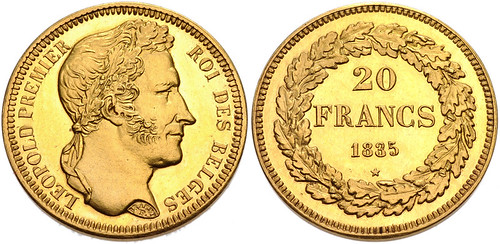
Belgium 1835 Gold 20 Francs

Denmark 1864 RH 2 Riksdaler
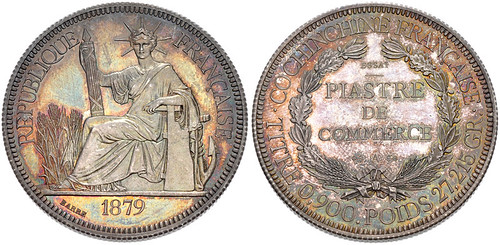
French Cochinchina 1879 Essai – Piastre de Commerce

Bolivia 1852 PTS FB Gold 8 Escudos

Chile, 1828 H Coquimbo Peso, NGC MS 63 – 970747
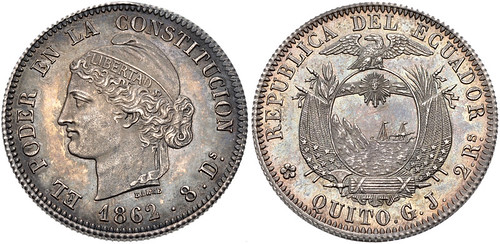
Ecuador 1862 GL 2 Reales, NGC PF 65 – 970776
To order the catalog, see: Lissner Collection (www.cngcoins.com/Coins.aspx?CATEGORY_ID=4349&VIEW_TYPE=0)
THE LOS ANGELES SUNDAY MORNING NUMISMATIC GET TOGETHER
The Sunday Morning Get Together
 In the 1970s, a group of numismatic friends decided to get together for a Sunday breakfast. We started at Factor's Deli and then branched out to other venues on the west side of Los Angeles and West San Fernando Valley. Some forty years later, we are still at it, Sundays at 9:30 AM.
In the 1970s, a group of numismatic friends decided to get together for a Sunday breakfast. We started at Factor's Deli and then branched out to other venues on the west side of Los Angeles and West San Fernando Valley. Some forty years later, we are still at it, Sundays at 9:30 AM.
The founding members, all committed numismatists, were Richard "Dick" Lissner, Irving "Irv" Goodman, and M. Louis "Mark" Teller. Within a year, we were joined by Dr. Lawrence "Larry" Adams, a prominent Los Angeles physician. Over the years such illustrious collectors as Dr. Osmund Chan, Dr. Robert Hesselgesser, and Paul Covey from San Antonio often appeared at the table. Wives, children, and grandchildren were often guests. Later, Dr. Vladimir Golovchinsky became a member of the group. Victor England sometimes joined the group when traveling through the area. Vibrant numismatic conversation was always in the forefront, along with a wonderful show-and-tell of exceptional numismatic specimens.
Politics, world news, and other current events often led to vigorous conversation. The full spectrum of political thought was represented and explored. We were good friends and listened and debated with courtesy. We also spoke of personal matters. We were a close-knit group of cronies.
As we aged, our meetings were still vibrant but some members could not attend due to illness or other issues.
Recently, Dick Lissner passed away at the age of 87. Losing him was a devastating loss for us all. In addition to being a wonderful man, he was one of the great coin collectors in Los Angeles and worldwide. His collection, of impeccable quality, encompassed all world type coins of the 19th and 20th centuries, with the exceptions of Canada and the United States. Should a beautiful 17th or 18th century coin come along, he would add it to the collection.
His numismatic start was as a 10-year-old boy collecting Lincoln cents, and he once received a rare 1914-D in change on a Los Angeles street trolley. While in high school, he joined the U.S. Army Air Corps cadet program, and after graduating from high school, he joined the U.S. Army Air Corps in 1943. Upon returning home after the war, he attended Stanford University, and then graduated Cum Laude from University of California, Berkeley. After being accepted at Harvard, Yale, and other fine institutions of learning, he chose to attend Yale where he received his law degree. He married his wife Judy in 1952, and they lived in the Los Angeles community of Brentwood, where they raised their four children.
Dick's family were gold rush arrivals in California with an impressive background and history–from a Grand Rabbi in Lisse, Poland, to a great grandfather who left home at a tender age and settled in Massachusetts. His great grandfather then came to California by ship, crossing the Isthmus of Panama on foot before continuing on by ship to San Francisco. While in San Francisco, he became a successful businessman, marrying the daughter of another successful businessman. Her father was one of the original founders of the first professional baseball team in Oakland (the Oakland Oaks, established in 1879).
Coming from a successful business family, Dick's grandfather, Meyer Lissner was a successful attorney and was deeply immersed in politics and its inner workings. Dick was proud of the letters he inherited that had been exchanged by his grandfather and President Theodore Roosevelt. As a political reformer, Meyer was greatly at odds with the very conservative Los Angeles Times. The Times published several seemingly anti-Semitic cartoons of Meyer and their mutual animosity grew. Meyer was deeply immersed in California politics and was the campaign chairman of Senator Hiram Johnson, a Republican Senator from California from 1917 to 1945. Meyer Lissner died in 1930. During WWII, a U.S. Liberty ship was named for the late Meyer Lissner.
Richard's father was an assistant United States attorney in Los Angeles in the 1920s before joining the L.A. law firm of Loeb and Loeb, where he became a full partner. After practicing law for a period of time, Dick, who never cared for the legal profession, managed family properties in downtown Los Angeles. At one time, his maternal grandfather, Isidor Eisner, owned the largest number of high-rise buildings in the downtown area of Los Angeles. Most are still in existence.
Although Dick came from an affluent and highly connected family in Los Angeles, he always remained very down to earth in a friendly, outgoing way. He was, as his ancestors, very philanthropic. This writer's favorite memory is the time Dick left a theater in Santa Monica, California and saw a homeless man with no shoes. He promptly took off his own shoes and gave them to the man. He was always discreet and private and rarely spoke of his philanthropy.
His four children, now grown, were given top-notch educations both in the United States and Europe. He believed that education was the finest gift that could be given to one's offspring. The proceeds of the sale of his excellent Russian collection (sold in Triton X, January 2007) were given to his 11 grandchildren to further their education.
As a linguist and scholar of history, the numismatic world was comfortable for him. His numismatic endeavors are legendary. He only wanted the finest specimens to add to his ever-growing collection. He amassed amazing type collections of France, Scandinavia, the Low Countries, Italy, and the Balkan States. He also collected crowns of the world. He was especially fond of Spain and the New World, and his collection of South American coins is known by dealers and collectors worldwide.
This August 1st and 2nd his collection will be offered for sale in the Chicago area before the annual ANA summer convention. It will be the finest sale of its type in 50 years.
We will miss "Dicky Boy," but his legacy will live on with his family and friends. His coins will find new homes. Richard Lissner always said; "We are only numismatic caretakers." He was right and these coins will live on as his numismatic legacy.
Thank you Dick, we miss you.
Mark Teller, April 2014
THE BOOK BAZARRE
RECIPE FOR MAKING COUNTERFEIT U.S. NOTES
An area counterfeiting operation turned real $5 bills into $50 and $100 bills using digital printers and a readily available bleaching agent.
Thus far three people have pleaded guilty to charges in the scheme that involved making phony bills good enough to fool merchants using counterfeit bill detection pens. It began in March 2012 and ended this summer.
The counterfeiting procedure was described in detail in an affidavit Halin filed in September.
The counterfeiters start with real $5 bills printed between 1996 and 2006 with Lincoln's portrait and a watermark of Lincoln's face.
They apply "Purple Power" cleaner on the $5 bills, heat them in a microwave, scrub the ink off with a toothbrush, dry them with a hair dryer, and then tape them to separate sheets of copy paper.
The sheets are fed into a multifunction printer and scanner machine. A genuine $50 or $100 bill is scanned and each side is then copied onto the bleached bill, making a counterfeit bill. The counterfeits are placed inside a book or magazine to flatten them.
Portraits of Ulysses S. Grant and Benjamin Franklin with watermarks closely resembling their portraits appear on genuine $50 and $100 bills, respectively.
Though bleaching removes the original ink, the Lincoln watermark remains on the bills, which are passed with the hope that merchants do not inspect the watermark closely to see if it is a Grant or Franklin portrait instead of Lincoln's.
Because the fake bills are made with real U.S. currency paper - 75 percent cotton and 25 percent linen with small, randomly dispersed red and blue security fibers - they have the look and feel of real bills.
To read the complete article, see: Richmond-area counterfeiting scheme turned $5 bills into $50s (articles.dailypress.com/2013-12-09/news/dp-wire-counterfeiting-scheme-1209-20131209_1_phony-bills-real-bills-watermark)
COUNTERFEITER FRANK BOURASSA

There is something wrong with the image that accompanies this story. Of the two $20 bills shown, one of them is fake. Can you tell which?
For its latest investigation, ABC News’ “20/20″ caught up with a master counterfeiter who says he taught himself how to make fake U.S. currency and printed $20 bills that were virtually undetectable – millions of dollars-worth.
“I’m the world’s best counterfeit right now. No one better than me. It’s me,” Frank Bourassa says in the interview. “I started from scratch…”
So, did you guess which bill is counterfeit?
The top one is legal tender, the bottom is its illegal twin brother.
To read the complete article, see: Counterfeit Investigation: Can You Spot the Fake $20? (abcnews.go.com/blogs/headlines/2014/05/counterfeit-investigation-can-you-spot-the-fake-20/)
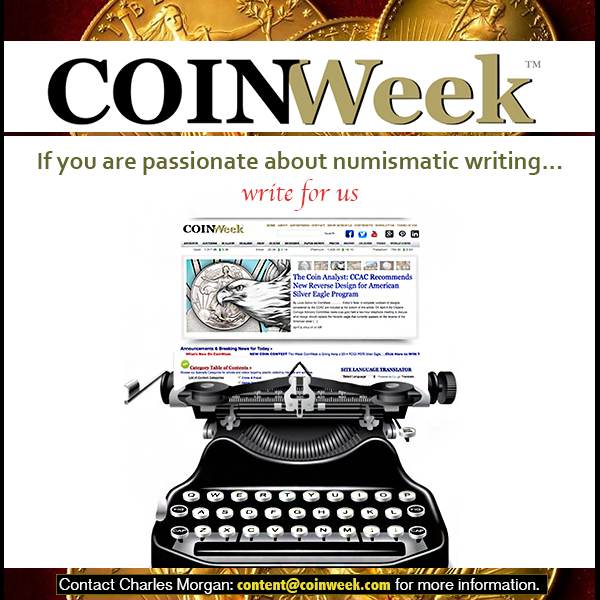
SUDBURY'S BIG NICKEL GETS A NEW MEDAL
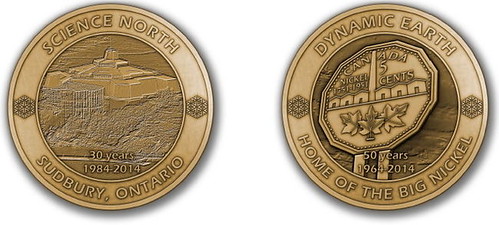
Long-time residents of Sudbury know we love all things coin related. Whether they're medals, medallions, tokens or medallets, we can't get enough. Did you know? Collectors of these types of items are called exonumists.
Medals became popular in the Sudbury area in the 1960's according to Jeff Fournier, former president of the Nickel Belt Coin Club and author of the book Sudbury Numismatics. Over 100 numismatic items have been produced in the Sudbury area.
"The impetus for [the popularity of the medals] was Ted Szilva and the Big Nickel," Fournier said. Szilva began minting medals to support the Canadian Centennial Numismatic Park project he had undertaken. A private project, Szilva came up with the novel way of minting the medals as a way to raise money to build the park's attractions.
In 1964 the first medals were minted and sold. The obverse of the medal featured the Big Nickel Monument and the reverse displayed Inco's reduction plant. Only 300 of these were minted in the first run.
Those 300 medals sold out within days and Szilva ordered more trying to meet the demand for this commemorative piece. With that first medal began Sudbury's obsession with medals, medallions, medallets and tokens.
In May of 1964 the Big Nickel monument was erected and dedicated on July 22, the Big Nickel's official birthday. The original base for the Big Nickel was made of rich Sudbury ore, which was replaced in 2003 by the stainless steel posts now used to support the Big Nickel. Silva continued to grow the numismatic park, including the addition of a 1965 Canadian one-cent piece known at the "Fantasy Copper" because of the sponsorship from Fantasy Copperware Canada.
In the late sixties, medals were in their "heyday," according to Fournier. Replica medals were released for both the Big Nickel and Fantasy Copper. They were released in a variety of metal compositions as more visitors asked for affordable souvenirs to bring home.
By the time all the monuments were constructed, the park was home to five mammoth coins: the Big Nickel, the Fantasy Penny, the Lincoln Penny, the Kennedy Half Dollar, and the Twenty Dollar Gold Piece.
Szilva operated the park until 1982 when it was sold to the city of Sudbury. In 1984, Science North opened and began operating the park. The attraction was renamed from "The Canadian Centennial Numismatic Park" to "The Big Nickel Mine."
In 2003, "The Big Nickel Mine" had been transformed and reopened as Dynamic Earth; an interactive, hands-on earth science centre.
The remaining large coin on display is the world-famous Big Nickel. The whereabouts of the other coins is a lingering question for some. When Fournier was researching for his book, he looked for answers as to what happened to the other monuments.
"I did track down a maintenance person who had worked at the Big Nickel, and he claimed all the monuments were taken down and sold for recycling," Fournier said.
While the coins may have been taken down and sold off, at least one component remains. Fournier said the base for the twenty-dollar coin monument is sitting as a decoration in the front yard of a Northern Ontario town.
Fournier is working on another book about Sudbury area medals, medallions, tokens and medallets, to be released in 2014. He hopes this one will fill in some information missing from his first book and it will contain an up-to-date catalog of the Sudbury area's world of exonumia.
In true Sudbury fashion Dynamic Earth is releasing a commemorative medal in celebration of the Big Nickel's 50th birthday as well as Science North's 30th anniversary. The 45mm brass medal will feature an aerial view of Science North with "30 years 1984-2014" overlaid on the picture. Along the edge "SCIENCE NORTH SUDBURY ONTARIO" is written with two snowflakes pictured. On the reverse is an image of the Big Nickel with "50 years 1964-2014" overlaid on the picture. Along the edge "DYNAMIC EARTH HOME OF THE BIG NICKEL" is written with two snowflakes pictured.
The medals are available starting today at a price of $19.95, at both Science North and Dynamic Earth. There will be 1,000 medals minted in the first issue.
To read the complete article, see: Science North: Celebrating Sudbury's special currency (www.thesudburystar.com/2014/05/17/science-north-celebrating-sudburys-special-currency)
To read earlier E-Sylum articles, see:
CANADA'S BIG NICKEL CELEBRATES AN ANNIVERSARY
(www.coinbooks.org/esylum_v12n30a22.html)
BIG NICKEL MEDAL IMAGE FOUND
(www.coinbooks.org/esylum_v12n32a11.html)
THE BIG NICKEL MEDAL
(www.coinbooks.org/esylum_v12n31a20.html)
FEATURED WEB PAGE: JOAN OF ARC MEDALS
This week's Featured Web Page is on Joan of Arc medals, suggested by George Cuhaj. The site is in French.
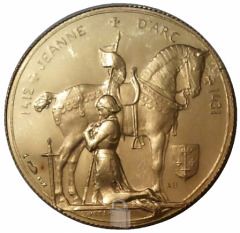
www.medailles-jeannedarc.fr
